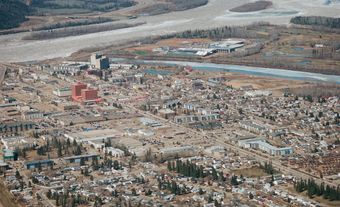Regional Development Planning
Regional Development Planning is undertaken by governments with the aim of improving the well-being of people in areas where there is concern about present and future living conditions. Economic conditions normally receive the greatest attention, but economic problems (such as high rates of unemployment, low income levels or lack of investment opportunities) are closely associated with a broad range of physical and social problems. These include substandard health and housing conditions, inadequacies in physical infrastructure (eg, water supplies, waste disposal, transport facilities), environmental pollution, and deficiencies in educational, recreational and social services. A planned program of regional development normally attempts to treat these problems comprehensively.
Canada has a long history of development programs of many kinds, the most notable being the system of income transfers among the provinces that followed from the Rowell-Sirois report of 1940. Yet the federal government did not adopt an integrated approach to the problem of regional disparities until 1969, when the Dept of Regional Economic Expansion (DREE) was established. DREE's chief purpose was to help create employment opportunities, but 2 levels of need were recognized. The first related to "designated regions" where unemployment was high but the infrastructure for development was already in place; here, grants were provided to firms willing to invest in new or expanded manufacturing plants. The second were "special areas" where infrastructure was not available, and social facilities and services were lacking as well. For these areas, DREE adopted comprehensive programs that included the development of industrial parks, vocational training, the construction of new housing, the provision of a wide range of health and social services, and the creation of jobs, which could be in service industries or in manufacturing. Both types of programs were funded and administered as federal-provincial partnerships, although the federal government bore a larger proportion of costs in the poorer provinces.
Beginning in 1973, in response to criticisms that the regional development programs were too much under central control, the provincial governments were given more autonomy over the design and implementation of projects supported by DREE. Then, in 1982, most of DREE's programs were moved to a Dept of Regional Industrial Expansion (DRIE) in the Ministry of Trade and Commerce. A new Ministry of Economic and Regional Development was created at this time to co-ordinate federal government actions to generate beneficial regional impacts. With the national economy performing badly, it came to be argued that regional development could not be effective unless well-thought-out development strategies had first been formulated at the national and provincial levels. If regions were left to compete with one another for limited opportunities, it was feared that Canada would fail to develop an international comparative advantage in such emerging fields as communication electronics or northern transport equipment.
In 1987 the federal government effected several significant changes in regional development policy. Firstly, a new Ministry of Industry, Science and Technology was created to formulate national development policy, particularly in the context of making Canada more competitive internationally. This new ministry is an amalgam of the former Ministry of Science and Technology and DRIE and, to some extent, replaces the functions of the Ministry of Economic and Regional Development which was disbanded in 1984. Secondly, 3 regional development agencies were created. One, the Department of Western Diversification, is designed to be a planning agency and a conduit for funds to assist in the diversification of western Canada's economy. Another, the Atlantic Canada Opportunities Agency, is designed to plan and deliver projects and programs to improve welfare and expand the economy of the Atlantic Region. A third agency, the Federal Northern Ontario Development Agency (Fednor), is designed to plan and fund economic expansion and employment creation, including the tourism sector, in northern Ontario. It is possible that additional agencies will be created; eg, there has been discussion of a similar agency for the northern Territories of Canada. The creation of these new agencies indicates a trend toward creating larger regions for developmental programming in Canada - 2 of the new agencies are multi-provincial in composition. In all cases, the emphasis is on strengthening large-scale regional economies by concentrating on areas of potential comparative advantage. These swings in federal government policy reflect a fundamental disagreement about the proper approach to regional development in Canada. For their part, provincial governments have shown little enthusiasm for the idea of national strategies or plans. In general, provincial governments have seen regional development planning as their responsiblity, on the grounds that they are closer to the problem areas than any national agency and have a better understanding of regional needs and priorities. Certainly the various provincial governments have instituted a wide variety of development programs of their own over the years, and are likely to continue to do so.

 Share on Facebook
Share on Facebook Share on X
Share on X Share by Email
Share by Email Share on Google Classroom
Share on Google Classroom


